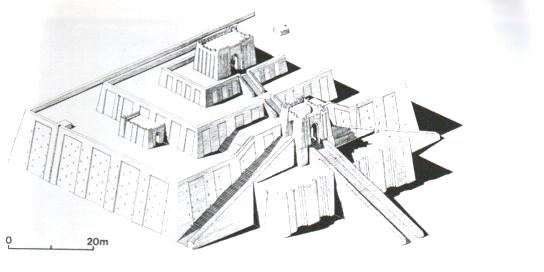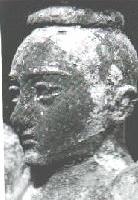Ur III Dynasty (2113-2004)
 |
| The Ziggurat of Ur |
The Ur III State not only restored the Akkadian Empire, bring unification, but it also gave Mesopotamia a century of peace and prosperity. Their empire was the most "nation-state" of the Mesopotamian empires to date, and it had the most extensive beaucracy seen up till then. The Ur III Empire took the conscious decision to re-establish Sumerian as the official language, to promote its use and also to promote Sumerian culture. The kings of Ur became known more for their building projects than their prowess in battle. This period is sometimes called the Neo-Sumerian Empire.
Ur
3rd Dynasty
Ur-Nammu (2113-2095)-He was appointed military governor of Ur by Utuhengal. Upon the death of the king  of Uruk, Ur-Nammu declared himself King of Ur, seized Uruk, and attacked and killed Namhani, the traitor of Lagash. He ruled all of Sumer and much of Assyria and Elam. Syria, including Ebla, paid tribute and may well have been part of the Empire. Even Phoenician Byblos was forced to pay. Thus we can divide the empire into two sections. The first was the Empire proper: he ruled Mesopotamia outright and imposed the State's will over all the cities. The second section could be called the dependencies or tributaries: The foreign lands who were forced, either by military conquest or threat to send tribute to the Ur III State. He called himself the "King of Ur, King of Sumer and Akkad". He initiated many building programs and promoted the Sumerian "way of life". Ur-Nammu "freed the land from thieves, robbers, and rebels", restoring order and peace. He re-fortified the towns of Sumer against any future unrest. It was long thought that he wrote the oldest known law code, but many scholars now think that his son Shulgi actually did. He died fighting the Gutians, who continued to remain a problem.
of Uruk, Ur-Nammu declared himself King of Ur, seized Uruk, and attacked and killed Namhani, the traitor of Lagash. He ruled all of Sumer and much of Assyria and Elam. Syria, including Ebla, paid tribute and may well have been part of the Empire. Even Phoenician Byblos was forced to pay. Thus we can divide the empire into two sections. The first was the Empire proper: he ruled Mesopotamia outright and imposed the State's will over all the cities. The second section could be called the dependencies or tributaries: The foreign lands who were forced, either by military conquest or threat to send tribute to the Ur III State. He called himself the "King of Ur, King of Sumer and Akkad". He initiated many building programs and promoted the Sumerian "way of life". Ur-Nammu "freed the land from thieves, robbers, and rebels", restoring order and peace. He re-fortified the towns of Sumer against any future unrest. It was long thought that he wrote the oldest known law code, but many scholars now think that his son Shulgi actually did. He died fighting the Gutians, who continued to remain a problem.
Shulgi (2095-2047)-Son of Ur-Nammu. Shulgi ushered in a period of prosperity. Scholars now think that it was him, and not his father, who published the oldest known law code. He completed Ur-Nammu's building projects and re-organized the administration of the kingdom. The Empire remained largely intact, with the Ensi's becoming provincial governors but with no military power. The local garrison's were put under the control of royally appointed military commanders so as to lessen the chances of revolt. He had considerable trouble pacifying the Assyrian territories, which called for yearly campaigns beginning in the 24th year of his reign. He finally succeeded in turning the northern area, with its Hurrian, Subartian, and Assyrian populations into a province in 2051 after twenty years of war. He also led punitive campaigns against the Amorites. The Gutians overran Elam, causing a greater state of anarchy there than had previously existed in Sumer. He wed his daughters to the rulers of Warshe and Anshan and then invaded, occupied Susa, and installed a Sumerian governor. He later had to put down a revolt in Anshan. Elamites were recruited into a "Foreign Legion"-type army. In c.2055, he lead an army into Palestine to punish the locals for not sending tribute. He may have tried to emulate Naram-Sin, for he took the title of "King of the Four Quarters" and had himself deified. He was a great patron of everything Sumerian, even though he married a Semite, Abisimti. She was to remain as dowager under her sons. Shulgi had more than 50 children.
Amar-Sin (2047-2038)-Son of Shulgi. He waged numerous campaigns against the Amorites. His time was divided between building projects and wars in Assyria against the Hurrians. He may have lost the Syrian and Elamite tributaries. He had himself deified and called the "God who gives life to the Country" and the "Sun-God [i.e. judge] of the Land". He died of an infection, which is ironic, since illness was seen as a sign of the displeasure of the gods.
Shu-Sin (2038-2029)-Brother of Amar-Sin. He also had himself deified. More wars were fought with the Amorites. He lost Assyria and erected a huge wall between the Tigris and the Euphrates a little north of Babylon in order to help contain the Amorites. The wall was 270 km long and breached the banks of both rivers. He also campaigned in the Zagros and defeated a coalition of Iranian tribes. He had extensive trade relations with the Indus Valley civilization.
Ibbi-Sin (2029-2004)-Son of Shu-Sin. The last king of Ur. New attacks by Elamites and Amorites forced the erection of new walls around Ur and Nippur. His situation was insecure and even pathetic throughout much of his reign. The realm began to disintegrate almost immediately. Much of the time he was confined to Ur itself. Eshnunna broke away in 2028 and Elam the next year. The Ensis of most of his cities deserted him and fended for themselves against the Amorites who were ravaging Sumer. He put a servant, Ishbi-Erra, in charge of Nippur and Isin. Ishbi-Erra in turn extended his sway along the rivers from Hamazi to the Persian Gulf. He took prisoner Ibbi- Sin's Ensis and installed his own. He did all of this while Ibbi-Sin was still on the throne. Severe famine and economic collapse ensued. Finally the Elamites sacked Ur, taking him prisoner, and ending the Empire. He died in Elam.


 of Uruk, Ur-Nammu declared himself King of Ur, seized Uruk, and attacked and killed Namhani, the traitor of Lagash. He ruled all of Sumer and much of Assyria and Elam. Syria, including Ebla, paid tribute and may well have been part of the Empire. Even Phoenician Byblos was forced to pay. Thus we can divide the empire into two sections. The first was the Empire proper: he ruled Mesopotamia outright and imposed the State's will over all the cities. The second section could be called the dependencies or tributaries: The foreign lands who were forced, either by military conquest or threat to send tribute to the Ur III State. He called himself the "King of Ur, King of Sumer and Akkad". He initiated many building programs and promoted the Sumerian "way of life". Ur-Nammu "freed the land from thieves, robbers, and rebels", restoring order and peace. He re-fortified the towns of Sumer against any future unrest. It was long thought that he wrote the oldest known law code, but many scholars now think that his son Shulgi actually did. He died fighting the Gutians, who continued to remain a problem.
of Uruk, Ur-Nammu declared himself King of Ur, seized Uruk, and attacked and killed Namhani, the traitor of Lagash. He ruled all of Sumer and much of Assyria and Elam. Syria, including Ebla, paid tribute and may well have been part of the Empire. Even Phoenician Byblos was forced to pay. Thus we can divide the empire into two sections. The first was the Empire proper: he ruled Mesopotamia outright and imposed the State's will over all the cities. The second section could be called the dependencies or tributaries: The foreign lands who were forced, either by military conquest or threat to send tribute to the Ur III State. He called himself the "King of Ur, King of Sumer and Akkad". He initiated many building programs and promoted the Sumerian "way of life". Ur-Nammu "freed the land from thieves, robbers, and rebels", restoring order and peace. He re-fortified the towns of Sumer against any future unrest. It was long thought that he wrote the oldest known law code, but many scholars now think that his son Shulgi actually did. He died fighting the Gutians, who continued to remain a problem.